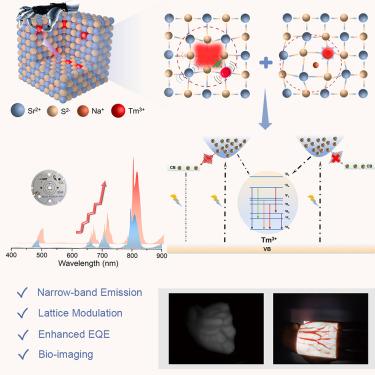Our official English website, www.x-mol.net, welcomes your
feedback! (Note: you will need to create a separate account there.)
Boosting narrow-band near-infrared-emitting efficiency of thulium by lattice modulation for reflective absorption bioimaging
Chem ( IF 19.1 ) Pub Date : 2024-10-21 , DOI: 10.1016/j.chempr.2024.09.024 Kaina Wang, Jipeng Fu, Sibo Zhan, Hongliang Dong, Chenjie Lou, Tianyi Sun, Jinru Liu, Bingyu Huang, Long Tian, Lihong Jiang, Ran Pang, Su Zhang, Huajie Luo, Mathieu Allix, Xiaojun Kuang, Shiqing Xu, Hongjie Zhang, Mingxue Tang
Chem ( IF 19.1 ) Pub Date : 2024-10-21 , DOI: 10.1016/j.chempr.2024.09.024 Kaina Wang, Jipeng Fu, Sibo Zhan, Hongliang Dong, Chenjie Lou, Tianyi Sun, Jinru Liu, Bingyu Huang, Long Tian, Lihong Jiang, Ran Pang, Su Zhang, Huajie Luo, Mathieu Allix, Xiaojun Kuang, Shiqing Xu, Hongjie Zhang, Mingxue Tang

|
Near-infrared (NIR) luminescence materials with narrow-band emissions are essential for brain and muscle activity imaging based on the absorption difference of oxygenated proteins. However, most known NIR-emitting materials are limited by low external quantum efficiency (EQE) and broadband properties. This work presents the careful design of Tm, Na-doped strontium sulfide (SrS: Tm3+, Na+) phosphor for NIR light-emitting diode (LED), which shows a narrow emitting band of 27 nm. The successful incorporation of Na+ into SrS: Tm3+ contributes to the suppression of lattice phonons, resulting in significant improvement in EQE from 33.6% to 53.7% and an increase in thermal stability. The efficient host absorption and energy transfer are facilitated by the crystallographic Sr defects and the distortion in the symmetric crystal, disclosed by solid-state NMR, electron paramagnetic resonance (EPR), transient spectra, and X-ray total scattering analysis. Subsequently, efficient identification of vascular patterns based on the differential absorption of hemoglobin enables the potential application of rare-earth luminescent materials in NIR phosphor-converted light-emitting diodes (pc-LEDs) and bioimaging.
中文翻译:

通过晶格调制提高铥的窄带近红外发射效率,用于反射吸收生物成像
具有窄带发射的近红外 (NIR) 发光材料对于基于含氧蛋白质吸收差异的大脑和肌肉活动成像至关重要。然而,大多数已知的 NIR 发射材料都受到低外部量子效率 (EQE) 和宽带特性的限制。这项工作介绍了用于 NIR 发光二极管 (LED) 的 Tm 掺杂硫化锶 (SrS: Tm3+, Na+) 荧光粉的精心设计,其发射带为 27 nm。Na+ 成功掺入 SrS:Tm3+ 有助于抑制晶格声子,使 EQE 从 33.6% 显着提高到 53.7%,并增加热稳定性。固体核磁共振、电子顺磁共振 (EPR)、瞬态光谱和 X 射线全散射分析揭示了晶体学 Sr 缺陷和对称晶体中的畸变,促进了有效的宿主吸收和能量转移。随后,基于血红蛋白差异吸收的血管模式的有效识别使稀土发光材料在 NIR 荧光粉转换发光二极管 (pc-LED) 和生物成像中的潜在应用成为可能。
更新日期:2024-10-21
中文翻译:

通过晶格调制提高铥的窄带近红外发射效率,用于反射吸收生物成像
具有窄带发射的近红外 (NIR) 发光材料对于基于含氧蛋白质吸收差异的大脑和肌肉活动成像至关重要。然而,大多数已知的 NIR 发射材料都受到低外部量子效率 (EQE) 和宽带特性的限制。这项工作介绍了用于 NIR 发光二极管 (LED) 的 Tm 掺杂硫化锶 (SrS: Tm3+, Na+) 荧光粉的精心设计,其发射带为 27 nm。Na+ 成功掺入 SrS:Tm3+ 有助于抑制晶格声子,使 EQE 从 33.6% 显着提高到 53.7%,并增加热稳定性。固体核磁共振、电子顺磁共振 (EPR)、瞬态光谱和 X 射线全散射分析揭示了晶体学 Sr 缺陷和对称晶体中的畸变,促进了有效的宿主吸收和能量转移。随后,基于血红蛋白差异吸收的血管模式的有效识别使稀土发光材料在 NIR 荧光粉转换发光二极管 (pc-LED) 和生物成像中的潜在应用成为可能。






























 京公网安备 11010802027423号
京公网安备 11010802027423号